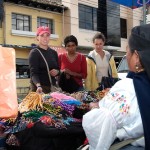Where Community Developed Worked in Latin America
While many, many PCVs involved in Community Development felt they were failure, and some were, still projects on the whole were working. “The Community Development Program in Peru is healthy,” wrote Herb Wegner in a 1963 Peace Corps Evaluation Report on Peru, “The question in Peru is not so much of going from bad to good—but from good to better.”
The large program in Colombia was also basically sound. By January 1964, over six hundred PCVS were working various projects and despite the site, it was successful. Meridan Bennett in his Evaluation Report summed up, “the Peace Corps’ ability to work in Community Development has been proven in Colombia.”
And both of these early Evaluators in Charlie Peters office were hard edged reporters.
The reason for the ‘success’ was because most of the projects in-country were ‘undefined.’ PCVs were free to tackle everything, and they did! Volunteers in Latin America went into literacy-teaching, arts and crafts classes, agricultural extension, and ante-and post-natal care.

Ecuador PCV
Jack Vaughn, who knew and understood Latin America, and later would become the second director of the Peace Corps, wrote about PCVs assigned to the high plains near Lake Titicaca, in the Andes on the border of Peru and Bolivia, saying that he had approached with trepidation the region because of the ‘hostile attitude of the Indians there. “They were all armed, they seemed resentful, didn’t speak Spanish and didn’t change.’
After visiting five villages where the PCVs had been for three years he wrote: “They had all built a new school, the first school in a thousand years. They all had a clinic for child deliveries, the first clinic in a thousand years. They all had potable water piped in and they had done it themselves. They had made more physical progress in a couple of years than they had made in the previous thousand. But more important was the attitude, the openness, the willingness to look you in the eye and tell you about who they were and what they had done, and the pride and self-respect of citizenship.”
Vaughn concluded that much of this change was due to the Peace Corps. In Kirby Jones article The Peace Corps Volunteers in the Field: Community Development in the May 1966 Annals, Vaughn is quoted: “What the Spaniards and Incas and the Western miners and the diplomats and the AID people couldn’t do in a thousand years the Peace Corps had helped to do in about three years. This is real revolution.”
End of Part Five. Next, With a Little Help From Our Friends!
…and we are still doing basic Community Development work, after we get to know the community and they us. Unlike USAID, we build communities not monuments! And the Third Goal is implemented following the principles of Acción Comunal. Hope our Jack Vaughn reads this series…Bob
Community Development is a very complex concept. For some of
the factors involved, I would cite, again, Dr. Textor’s classic “Cultural Frontiers of the Peace Corps.” The section, “Pitfalls and Progress in the Peruvian Sierra,” is written by PCV staffer and Anthropologist, Paul L. Doughty and speaks to CD in the Andes during the same timeframe referenced in John’s article. It is excellent because it cites some of the factors that contributed to success or failure during that time.
My site in Colombia was one visited by Meridan Bennet in 1964. I want to review his evaluation report, again, before I comment.
Although many of us struggled finding a way to contribute in those early months in Arequipa, Peru, there were just as many who grabbed an opportunity and carried it to fulfillment through health, nutrition, education, and construction projects, as examples. After the disastrous Ica flood in 1963, I was transferred to this town near the coast and worked with other volunteers who were sent from throuoghout the country to help the community rebuild. Despite being trained as a speech therapist, I worked with practical nurse, Ruth Radshaw, who undertook to build a medical clinic for the indigenous population. Our clinic was primitive, but we kept it as clean as we could under the dire circumstances. We would have been arrested here for the services we rendered there, but you couldn’t have found a community more grateful for the basic but vital health care we delivered.